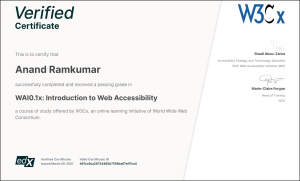Rethinking Accessibility in the Digital Age
Disability often isn’t a personal limitation—but a consequence of progress that wasn’t built for everyone. When digital platforms overlook accessibility, they inadvertently create barriers—not because users lack ability but because inclusion wasn’t considered from the start.
In a world increasingly reliant on digital platforms, accessibility is no longer a checkbox—it’s a cornerstone of responsible and effective digital transformation. At its core, web accessibility ensures that people of all abilities can perceive, navigate, and interact with digital content without barriers. But despite its growing relevance, accessibility is still misunderstood as a narrow design tweak or compliance requirement. The reality is far broader—and far more impactful.
At Experion, we’ve come to understand accessibility as both an ethical responsibility and a business advantage. When integrated early into design, development, and testing, accessibility transforms the way users experience technology. It’s not about retrofitting apps to check boxes. It’s about designing with empathy—and with standards like WCAG guiding every decision.
The WCAG Framework: POURing Accessibility into Design
The Web Content Accessibility Guidelines (WCAG), developed by the W3C’s Web Accessibility Initiative (WAI), provide the most widely accepted benchmark for accessibility compliance. These guidelines are built on four core principles—Perceivable, Operable, Understandable, and Robust (POUR).
- Perceivable: Information must be presented in ways all users can perceive—text alternatives for images, audio descriptions, sufficient contrast.
- Operable: Users must be able to navigate content, whether by keyboard, voice, or other assistive technology.
- Understandable: Content should be consistent, readable, and predictable.
- Robust: Websites must be compatible with evolving assistive technologies and future-proof in structure.
Evolving Standards: WCAG 2.0, 2.1, and 2.2 Compared
Accessibility isn’t static—it adapts to new devices, behaviors, and user needs. The WCAG standard has evolved significantly since its inception. Here’s a quick comparison:

At Experion, our accessibility testing frameworks are aligned with evolving standards and global regulations.
More Than Compliance: Why Accessibility Matters for Business
What’s often missed in accessibility conversations is the business upside. Globally, over 1.3 billion people live with some form of disability. That’s not a niche market—it’s a massive segment of potential users.
Beyond moral and legal obligations, inclusive design leads to:
- Expanded reach across geographies and demographics.
- Reduced legal risk—in 2023 alone, over 4,500 ADA-related lawsuits were filed in the U.S.
- Stronger SEO—search engines prioritize accessible content.
- Increased customer retention—71% of users with disabilities will leave a site that isn’t accessible.
- Enhanced brand perception—a commitment to accessibility signals a commitment to all users.
Where Most Applications Fall Short
Accessibility barriers can be subtle, yet significantly disruptive. Among the most common challenges we uncover during testing are:
- Visual barriers: Missing alt text, insufficient contrast, inaccessible infographics.
- Motor barriers: Lack of keyboard navigation, inaccessible form fields.
- Cognitive barriers: Complex UI patterns, inconsistent behavior, auto-playing content.
- Auditory barriers: Missing captions and transcripts in video or audio-based content.
These issues not only affect people with disabilities—but also hinder usability for everyone.
Building Accessibility into the SDLC
Retrofitting accessibility after development is expensive and inefficient. That’s why Experion integrates accessibility early in the Software Development Lifecycle (SDLC)—starting from design workshops and extending into QA automation. We focus on:
- Shift-left accessibility testing.
- Component-level audits and reusable accessible design patterns.
- Automated and manual testing using tools like NVDA, Chrome Web developer, axe, WAVE, and many more.
- Real-world validations with assistive technologies.
According to Deque’s research, fixing accessibility issues during the design or development phase is far more cost-effective than remediating them post-launch. By embedding accessibility in our culture and process, we ensure that inclusivity is not an add-on—it’s built in.
Author’s Note: Why This Matters to Me
Having completed formal training from W3C on web accessibility, I’ve come to appreciate the depth and nuance of accessible design. It’s not just a checklist—it’s a mindset shift. One that embraces the diversity of users we build for every day.

What has stayed with me the most is this simple yet powerful realization: the world often becomes more difficult not because of a person’s special abilities, but because it hasn’t been designed to include them. As someone who helps shape digital products, I see it as both a responsibility and a privilege to advocate for accessibility—because when we design for everyone, we build a better digital world for all.
At Experion, we believe that truly great digital experiences are those that leave no one behind. Accessibility isn’t just the future—it’s the present.

